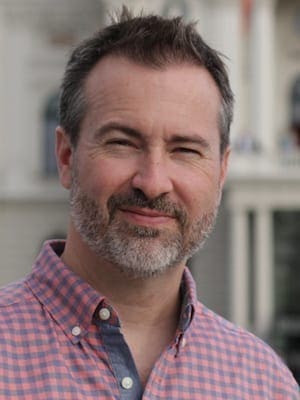To produce our new documentary, “Sacred Texts, Social Duty,” Robert Parham and I drove to Arkansas and Alabama and flew to Illinois, Virginia and Oregon. With neither time nor money for advance or follow-up visits, we got one chance to get the story.
We spent time – anywhere from an afternoon to three or four days – with more than two dozen people representing the Abrahamic faith traditions. We traveled first to Birmingham, Ala., in November 2009 to be on hand when the Tea Party Express held a rally in Kelly Ingram Park – a historic park at ground zero of the city’s civil rights movement. Our last trip was to Virginia in April 2010.
By month’s end, I would be editing in earnest and trying to whittle more than 30 hours of footage down to one before fall arrived.
Unfortunately, it’s not always obvious how to structure a documentary. Typically, original plans are at least tweaked if not scrapped altogether. For example, we began thinking the documentary would include examining the tax-exempt status of houses of faiths. However, that turned out to be a non-starter in several interviews.
The documentary we had just finished, “Different Books, Common Word: Baptists and Muslims,” progressed around five different storylines. We showed a beginning to each of the five stories, then another chapter in each of the stories, then another chapter, and so on.
“Sacred Texts, Social Duty” would be different, which we knew going in. While each state has a “story” (e.g., Illinois is carrying a deficit that’s half of the state budget), the structure would be less of a narrative and more of a topical presentation. We came up with four main segments or chapters:
1. Social Duty in the States
2. Social Duty in the Sacred Traditions
3. Social Duty in the Public Square
4. Social Duty and the Pulpit
After introducing the key players in each state in segment one, we proceeded to explore faith and taxes in a topical fashion: looking at what the Abrahamic texts and traditions say, looking at how leaders in those traditions have applied the teachings in the public square, and finally looking at how the pulpit has, or has not, dealt with moral taxation.
After assembling a 30-minute rough cut of just the first segment, it seemed too focused on legislative activity in the states. In other words, we thought it would appear “too political.” I re-focused the segment away from legislation and more toward the dynamic personalities we found across the country. The result was better, and I moved on to the following chapters.
To be sure, parameters are not necessarily the enemy, even in creative endeavors like documentary filmmaking. For example, we know our documentaries are often used in houses of faith, and their viewing is spread across multiple days. For that reason, in most of our productions we have tried to deliver a piece that can logically be divided into four segments. This matches the traditional four-week study. This structure, imposed on the project from the outside, can actually help you see a “floor and walls” amid all the footage.
There’s still plenty of work, however. Much of it involves identifying the best footage and seeing how footage A might relate to footage B and footage C, and so on. In the trenches of this work, my undergraduate degree in history – with its emphasis on researching, clustering, outlining and organizing material – has been invaluable.
My first “draft” of “Sacred Texts, Social Duty” was 10 hours. The next one was three. Then two. Then a little more than one. Going from 10 to 1 is relatively easy. Going from 90 minutes to 60 is where it hurts, where you “kill your darlings” – meaning you have to cut moments and lines you love.
Mixed into all of this is the search for things like supporting visuals and voiceover talent. I tend to avoid voiceovers if possible, but this project required some framing and contextualization that only seemed possible by using a voiceover.
Identifying appropriate music is one of the more enjoyable parts of this endeavor. Music establishes mood, provides energy and can help identify particular stories. For this project, I chose some well-known tracks by Tchaikovsky, Rimsky-Korsakov, Satie, Vivaldi and others. The richness, complexity and emotional wallop of these pieces seemed appropriate for a documentary on taxes.
Frankly, I’m not a fan of the documentary’s title, “Sacred Texts, Social Duty.” Descriptive, yes. Creative, no. The history of the title is too laborious to recount here. If I had my druthers, the documentary would be titled “Everybody Do Better.” The phrase comes from documentary interviewee Ralph Martire, a tax expert in Chicago. While distilling economics before our camera, Martire thought to quote his Grandma Tussio: “Everybody do better when everybody do better.”
I suppose Grandma Tussio meant it mostly as an observation: When any one of us succeeds, we all succeed. I think it also works as a command, as in: “Everybody, do better!”
Now that “Sacred Texts, Social Duty” is moving out into the world, it’s easy to see that we have been fortunate yet again to find exceptional people of faith. They are courageous, kind, informed, articulate.
Wading through their witness, I was reminded of Proverbs 25:11: “A word fitly spoken is like apples of gold in pictures of silver.” Day after day in the editing bay, apples of gold stood out in the pictures on my monitor.
A word fitly spoken on faith and taxes has scarcely been heard. Until now.
Cliff Vaughn is managing editor and media producer for EthicsDaily.com.
Editor’s note: To learn more about and order “Sacred Texts, Social Duty,” go to: SacredTextsSocialDuty.com.

